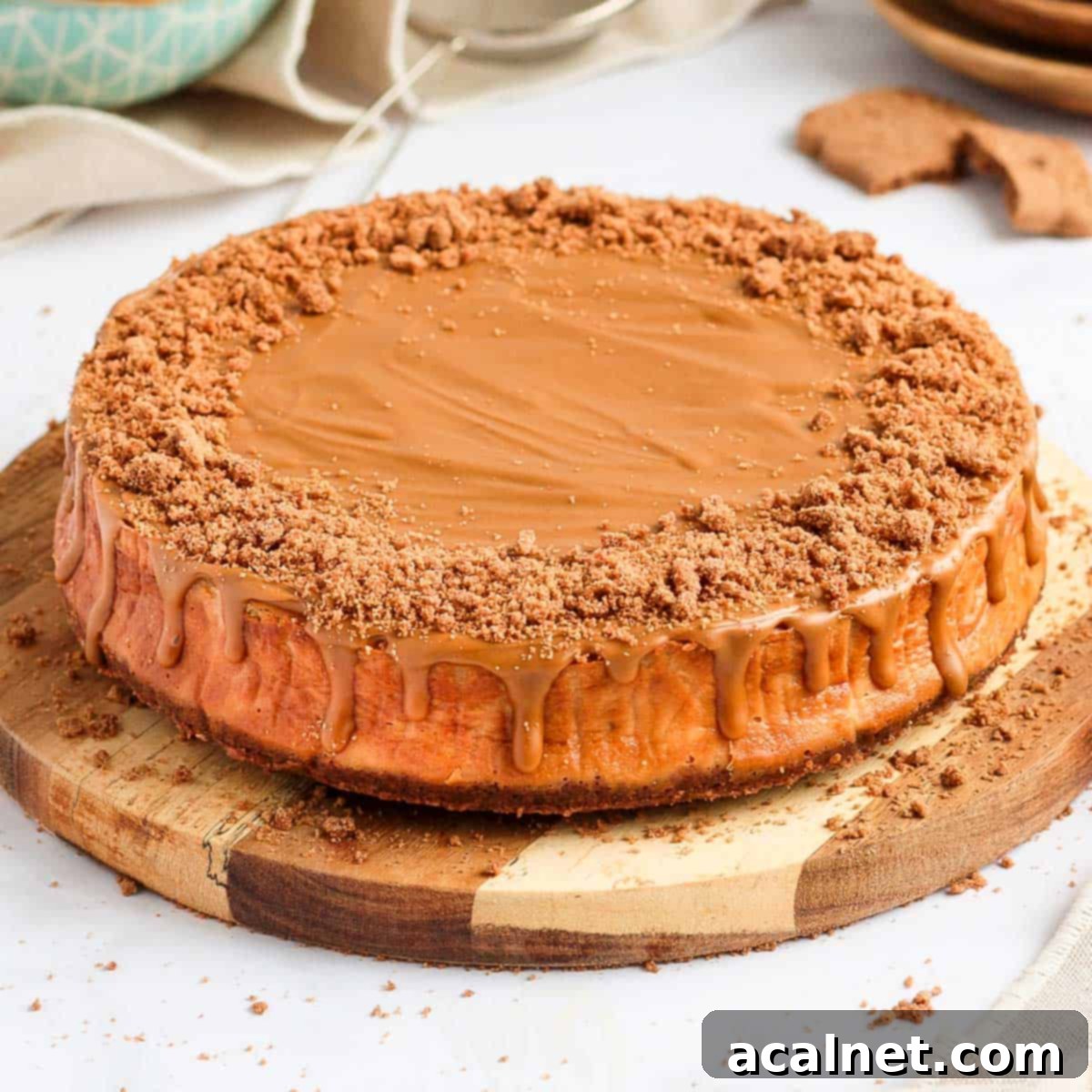Decadent Baked Speculoos Biscoff Cheesecake: The Ultimate Guide
Indulge in the ultimate dessert experience with this incredibly decadent Baked Speculoos Biscoff Cheesecake. Whether you’re celebrating a special occasion or simply craving a luxurious treat, this recipe promises to deliver a truly unforgettable culinary delight. You’ll savor the distinctive caramelised, spiced flavor of traditional Speculoos (also known as Biscoff) cookies, perfectly blended with the rich, dense creaminess characteristic of a classic baked cheesecake. Every bite offers a harmonious balance of texture and taste, from the crunchy cookie crust to the silky-smooth filling, all generously topped with a luscious Biscoff spread layer. This isn’t just a dessert; it’s an experience waiting to be created in your kitchen.
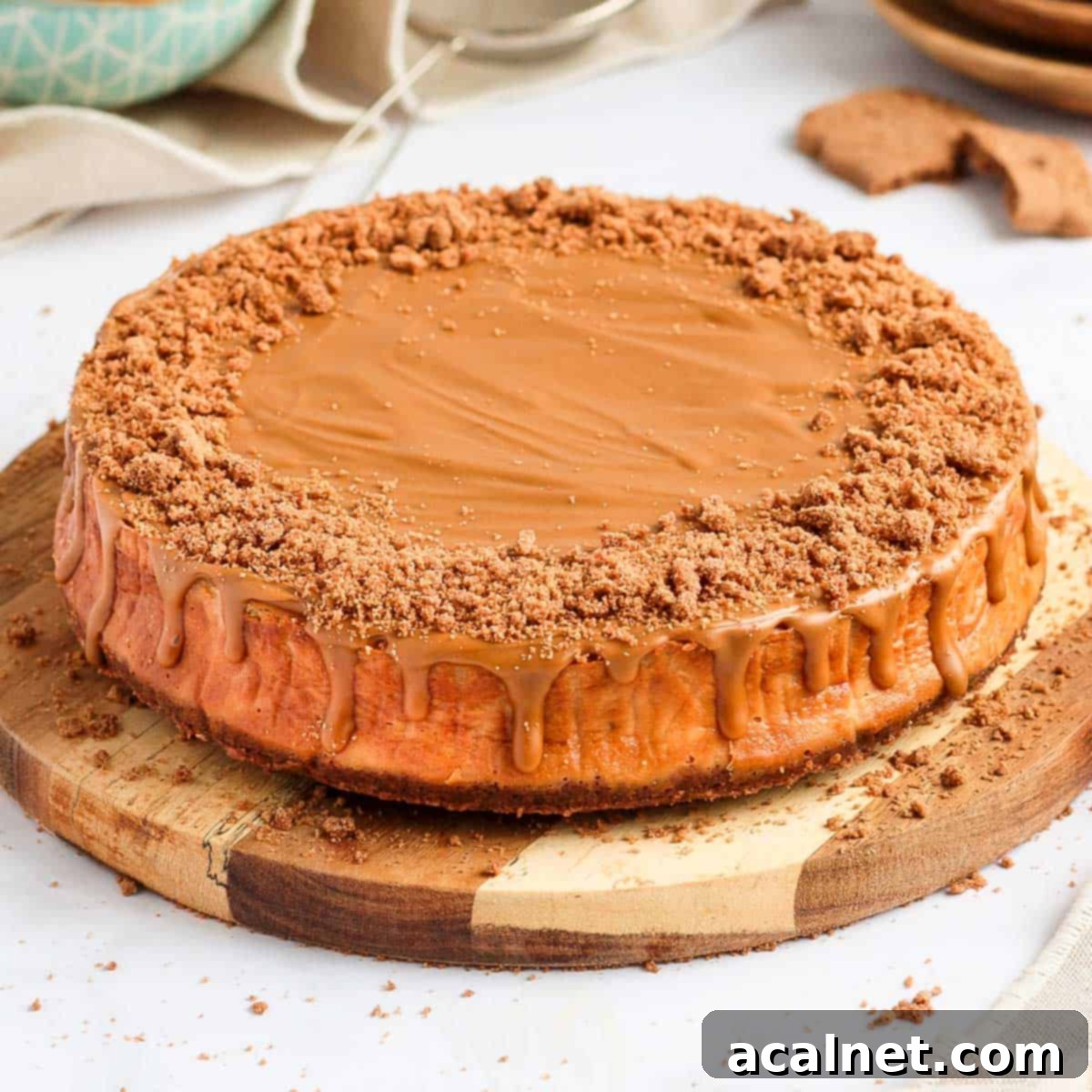
[feast_advanced_jump_to]
Why This Baked Biscoff Cheesecake is a Must-Try
This Speculoos Cheesecake holds a special place in my heart, primarily because Speculoos cookies, the very essence of this dessert, originate from my home country, Belgium. But beyond the nostalgia, this recipe is a celebration of the unique and incredibly comforting spiced, caramelised flavors and the signature crunch of Speculoos, or as many know them, Biscoff Cookies.
Prepare for a truly indulgent experience. This Biscoff Cheesecake recipe features a robust and crunchy Biscoff Cookie Crust that forms the perfect foundation. The creamy cheesecake batter itself is infused with rich Biscoff Spread, ensuring every bite is packed with that irresistible cookie butter flavor. To crown this masterpiece, a thick, luscious layer of melted Biscoff Spread, generously sprinkled with crushed cookies, creates an absolutely show-stopping finish. If you’re a devoted Speculoos lover, this seriously decadent cookie butter cheesecake is an absolute must-try. For those looking for different ways to enjoy these flavors, why not explore our Mini Biscoff Cheesecakes for a bite-sized treat or the incredibly easy No-Bake Biscoff Cheesecake for a quicker indulgence?
The magic of Speculoos cookies extends even to the crust, where their crushed form delivers an unparalleled depth of flavor and texture. Just like in my Passion Fruit and Raspberry Cheesecake, using these spiced shortbread cookies for the crust elevates the entire dessert. It’s safe to say, it’s my absolute favorite type of cookie crust! This recipe ensures a moist, creamy, and flavorful baked Biscoff cheesecake every time, making it a reliable choice for any dessert spread.
More Biscoff Recipes to Explore:
- Biscoff Cookie Butter Ice Cream
- Biscoff Truffles
- Easy Biscoff Cake
- Speculoos Tiramisu
- Biscoff Butter Cookies
- Biscoff Brownies
- Cookie Butter Cream Cheese Frosting
- Biscoff Cupcakes
- Easy Biscoff Donuts
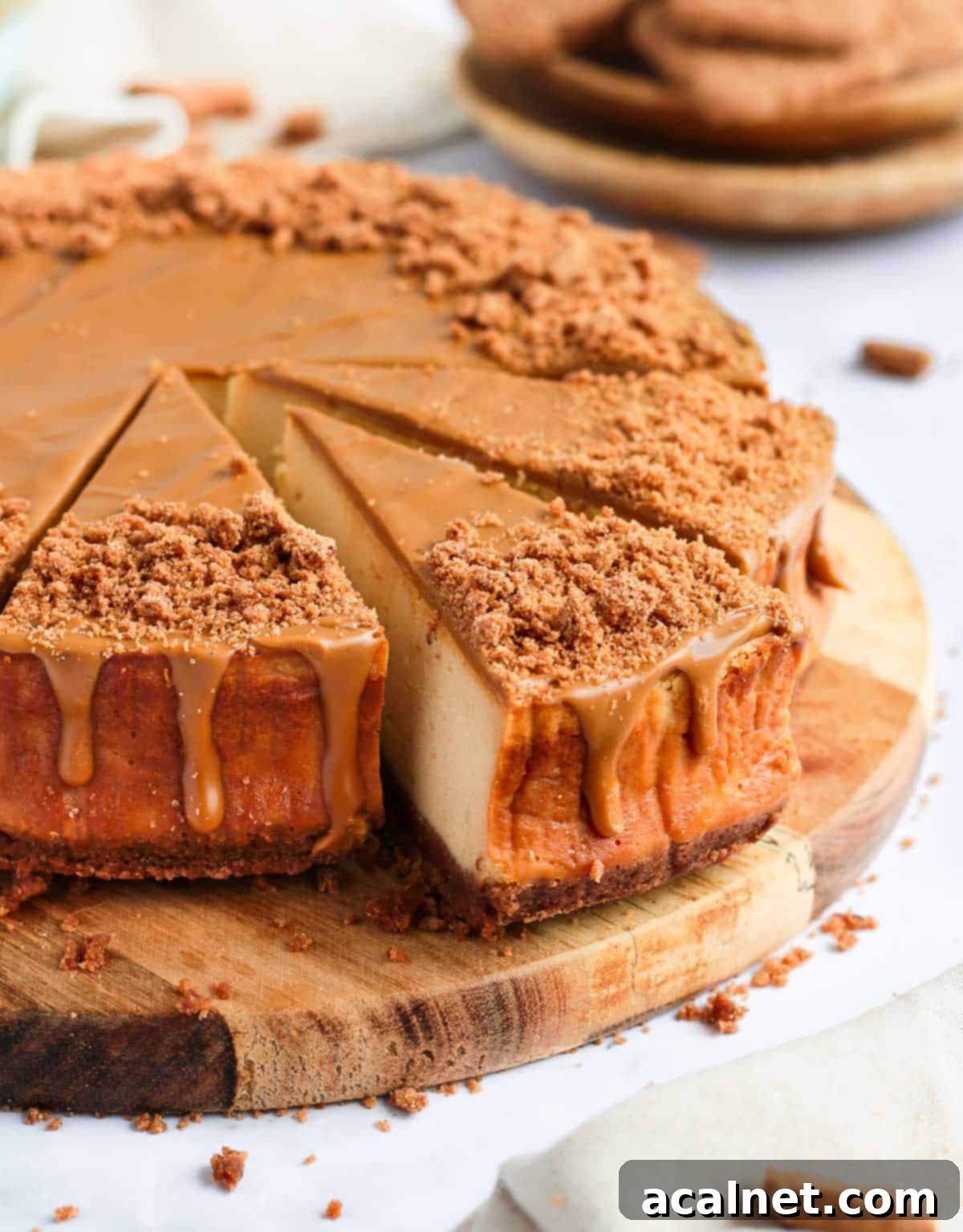
What Exactly Are Speculoos or Biscoff Cookies?
You might be most familiar with the name Lotus Biscoff Cookies, but the original and traditional name for these beloved biscuits is Speculoos (or sometimes *Speculaas*). These are classic Belgian and Dutch spiced shortbread cookies, deeply ingrained in cultural traditions. They are traditionally enjoyed around Christmas time, particularly during St. Nicholas Day celebrations in Belgium and the Netherlands, symbolizing warmth and festive cheer.
These distinctive cookies boast a delicious caramelised flavor derived from brown sugar (or beet sugar), beautifully complemented by a medley of warming spices. Their taste is often compared to gingerbread, though Speculoos typically offers a deeper caramel note and a slightly more complex, intense spice blend. Historically, they are often intricately shaped with unique patterns, such as windmills or figures of St. Nicholas, using special rolling pins or cookie stamps, adding to their charm.
The exact blend of spices used in these traditional cookies can vary depending on the brand and their country of origin (Belgium or the Netherlands). However, a typical Speculoos spice mix usually includes a fragrant combination of Cinnamon, Nutmeg, Cloves, Ginger, and/or Cardamom, creating their signature aromatic profile that is so central to our Baked Speculoos Cheesecake. This rich flavor is what makes them perfect for infusing into every layer of our delicious dessert.
For a deeper dive into the fascinating history and origin of Speculoos, you can explore more here.
Essential Ingredients for Your Biscoff Cheesecake
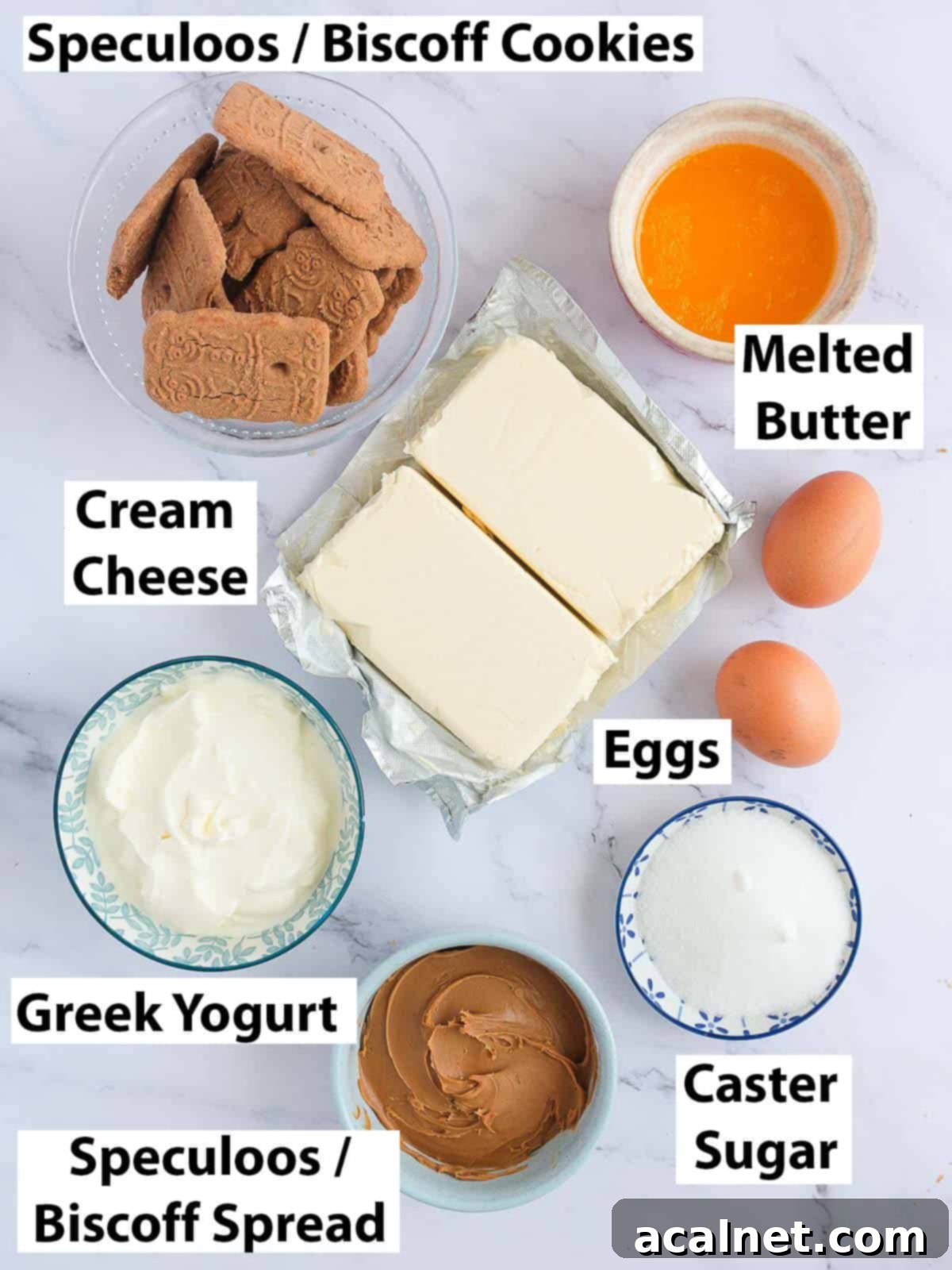
This delightful Biscoff cheesecake recipe surprisingly calls for just 7 key ingredients, with several of them being cleverly used across different layers of the cake to maximize that incredible Speculoos flavor. Here’s what you’ll need:
- Speculoos / Biscoff Cookies: These form the foundation of our crust. Different brands may have varying cookie sizes, so measuring by weight is highly recommended for accuracy. For reference, I typically use about 25 Speculoos cookies to achieve the perfect crust consistency.
- Butter: Unsalted and melted. This binds the cookie crumbs together for a firm, flavorful crust.
- Cream Cheese: The star of any cheesecake! Make sure to use full-fat cream cheese that comes in a block, not a cream cheese spread. The higher fat content is crucial for achieving that characteristic dense, creamy texture. Also, ensure it’s at room temperature for a smooth, lump-free batter.
- Greek Yogurt: Many classic cheesecakes call for sour cream, but I find Greek yogurt creates a wonderfully lighter and tangier texture. Full-fat natural yogurt or sour cream can be used as alternatives if Greek yogurt isn’t available, but I strongly recommend Greek yogurt for the best results. Like the cream cheese, it should be at room temperature.
- Sugar: I use simple Caster Sugar (fine white sugar). The Biscoff spread itself is quite sweet and caramelised, so you won’t need to add an excessive amount of sugar to the filling, ensuring the Biscoff flavor shines through.
- Eggs: Medium-sized and at room temperature. Eggs are vital for structure and richness in a baked cheesecake. Adding them one at a time ensures they are fully incorporated without overmixing.
- Speculoos Spread: Also widely known as Lotus Biscoff Spread or Cookie Butter Spread. This ingredient is pivotal for a true Speculoos Biscoff Cheesecake, infused directly into the batter for intense flavor and generously used as a decadent topping.
For an optional aromatic touch, consider adding a little bit of Vanilla Extract to the cheesecake mixture. It can subtly enhance the existing flavors without overpowering the distinct Speculoos profile.
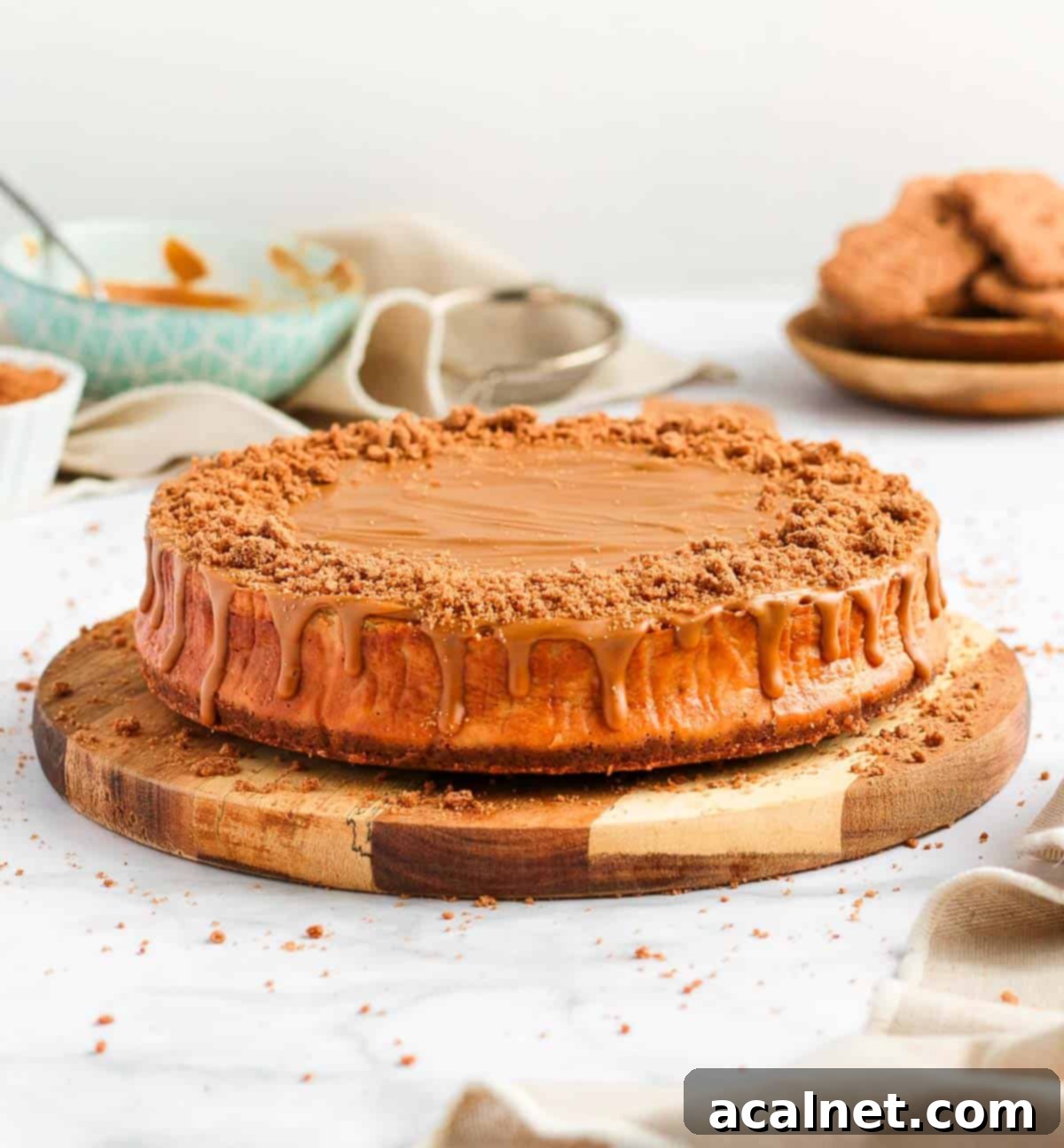
How to Make Baked Biscoff Cheesecake: A Step-by-Step Guide
Creating this irresistible Baked Biscoff Cheesecake is a straightforward process divided into three main stages: crafting the crunchy Speculoos cookie crust, preparing the smooth and flavorful cookie butter cheesecake batter, and finally, adding the crowning glory of a thick Biscoff spread layer with extra crushed cookies. Follow these steps for a perfect homemade Biscoff cheesecake.
1. Preparing the Perfect Speculoos Crust
The crust for this cheesecake is delightfully simple, requiring just two ingredients, much like many other classic cheesecake crusts: finely crushed cookies and melted butter. For the best consistency and ease, I recommend using a food processor to crush your Speculoos cookies, which ensures a uniform, fine crumb. While you can crush them by hand, a food processor will yield a more even texture, helping the crust hold together perfectly.
- Photo 1: Begin by crushing your Speculoos or Lotus Biscoff Biscuits into a very fine crumb. While a coarser crumb can add a rustic texture, a finer crumb will create a more stable and cohesive crust, preventing it from crumbling when sliced.
- Photo 2: Add the Melted Unsalted Butter to the crushed cookies. Pulse the mixture in your food processor (or mix by hand) until it achieves a thick, wet sand-like consistency. This indicates the butter has evenly coated all the crumbs, ready for compaction.
- Photo 3: Transfer the moist Biscoff cookie crumbs into a 24 cm / 9-inch Springform Pan. Ensure your pan is properly prepared by lining both the bottom and sides with baking paper, or by thoroughly greasing it, to prevent sticking and ensure easy removal.
- Photo 4: Using the back of a spoon or a flat-bottomed cup, firmly and evenly press the crumbs across the bottom of the pan to create a compact, uniform layer. This firm packing is crucial for a stable crust. Once pressed, place the pan in the fridge to chill for at least 30 minutes. This chilling period helps the butter solidify, setting the crust firmly in place before adding the filling.
If you’re making the crust by hand: Place the Speculoos cookies in a sturdy plastic ziplock or freezing bag. Use a rolling pin to smash the cookies until they are finely crushed. Transfer the crushed cookies to a mixing bowl, add the melted butter, and mix thoroughly with a spatula until you reach that desired wet sand consistency.
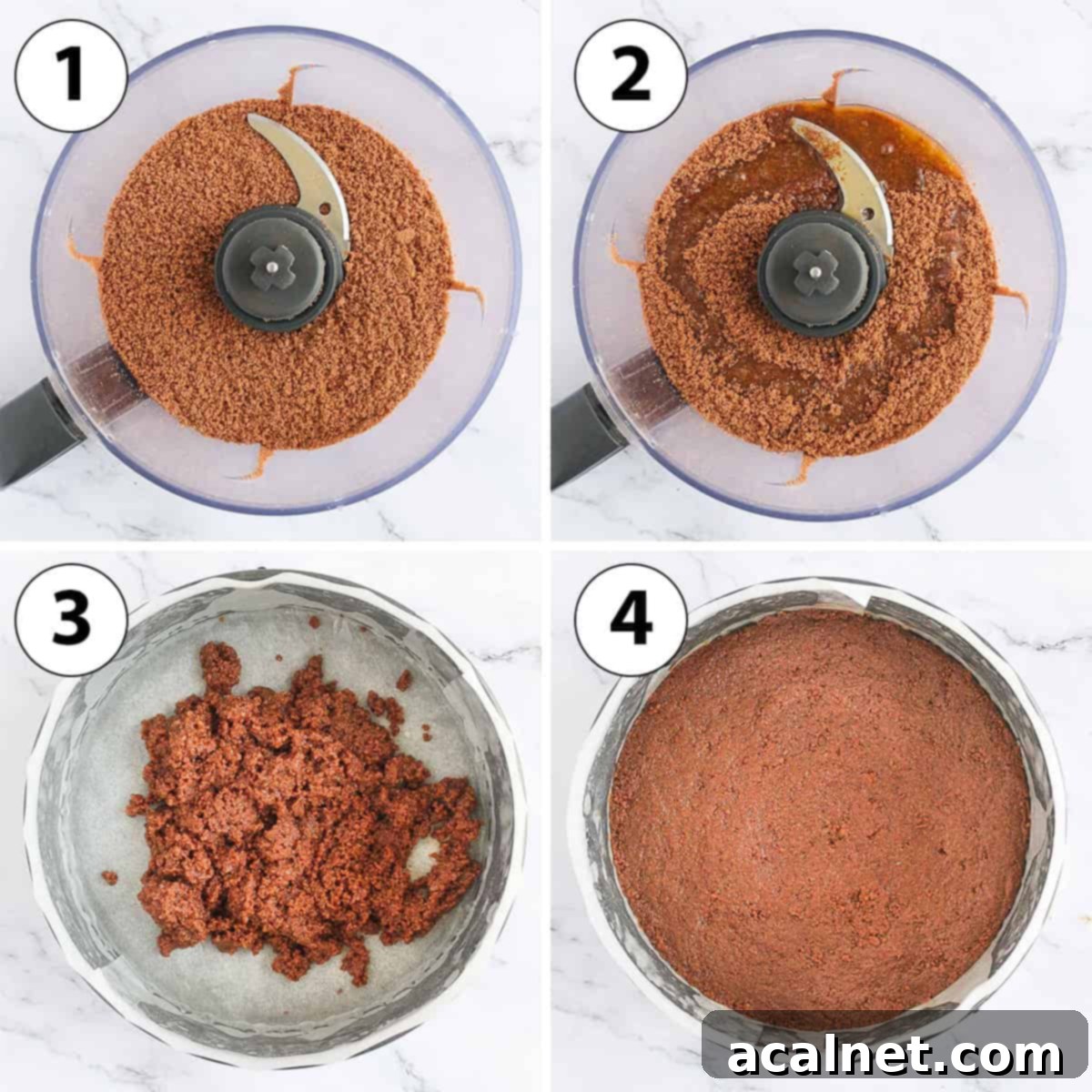
2. Crafting the Creamy Biscoff Cheesecake Filling
While your Speculoos cookie crust is chilling in the fridge, you can begin preparing the rich and smooth cookie butter cheesecake filling. This part of the process is crucial for achieving that signature creamy texture and incredible Biscoff flavor.
- Preheat your oven to 150°C / 300°F. This low and slow temperature is key to preventing cracks in your baked cheesecake.
- Photo 5: In a large mixing bowl (or the bowl of your stand mixer), combine the Cream Cheese, Greek Yogurt, and Speculoos/Biscoff/Cookie Butter Spread. It is absolutely critical that all these ingredients are at room temperature. This ensures they blend together seamlessly, preventing any lumps and resulting in a perfectly smooth batter.
- Photo 6: Using a hand mixer (or your stand mixer with the paddle attachment), whisk these ingredients together on medium speed until the mixture is completely smooth, light, and fluffy, with no lumps remaining. Be mindful not to over-mix at this stage, as incorporating too much air can lead to cracks or a dense texture in your finished cheesecake.
- Photo 7 & 8: Add the Caster Sugar (or fine white sugar) to the cream cheese mixture and continue mixing on low speed just until it is fully combined. Remember, the Biscoff spread already provides a good amount of sweetness, so a modest amount of added sugar is sufficient.
(*) If your Biscoff spread is too thick, you can gently warm it in the microwave for a few seconds to make it more fluid. This will help it combine more easily with the other ingredients.

- Photo 9 & 10: Gently add the Eggs, one at a time, mixing well between each addition until just combined. The goal is a smooth, fluid cheesecake batter. Over-mixing the eggs can incorporate too much air, which may cause the cheesecake to crack during baking.
- Photo 11 & 12: Carefully pour the luscious Speculoos cheesecake batter over your chilled cookie crust in the springform pan. Use the back of a spoon or a small offset spatula to gently spread it out, creating an even and smooth top surface.
- Once the batter is in the pan, gently tap the Springform Pan against a hard surface, like your kitchen counter, a few times. This simple yet effective step helps to release any large air bubbles that might be trapped within the batter. Trapped air can lead to cracks or a sunken center in your finished cheesecake, so this step is key for a flawless appearance.
- Place the cheesecake on the lowest rack of your preheated oven and bake for approximately 45 to 55 minutes, or until the cheesecake is set. To test for doneness, gently jiggle the pan back and forth in the oven; the center of the cheesecake should no longer wobble or jiggle. It should look mostly set with perhaps a slight jiggle in the very center.
- Once baked, turn off the oven and, crucially, leave the cheesecake inside the oven to cool down naturally for about an hour with the door slightly ajar. This gradual cooling process is vital for preventing the cheesecake from cracking or collapsing due to a sudden temperature change. After an hour, take it out of the oven and allow it to cool completely to room temperature. Once at room temperature, transfer the cheesecake to the fridge to set further for at least 2 hours, or ideally overnight, before topping.
- If you wish to create the elegant finish seen in my photos for your Lotus Biscoff cheesecake, ensure it has chilled in the fridge for at least an hour. Then, melt additional Biscoff Spread in the microwave until it is very liquid and fluid. Pour this melted spread evenly over the top of the chilled cheesecake. Use a small offset spatula to gently push the spread towards the edges, encouraging it to drip attractively down the sides. Finish by sprinkling some coarsely crushed Speculoos Cookies around the edges or across the top for extra texture and visual appeal.
For an even more extravagant Baked Speculoos Cheesecake (if that’s even possible!), consider adding a dollop of homemade whipped cream, either plain or lightly flavored with vanilla, before serving. It adds another layer of creamy indulgence that pairs beautifully with the spiced Biscoff flavors.
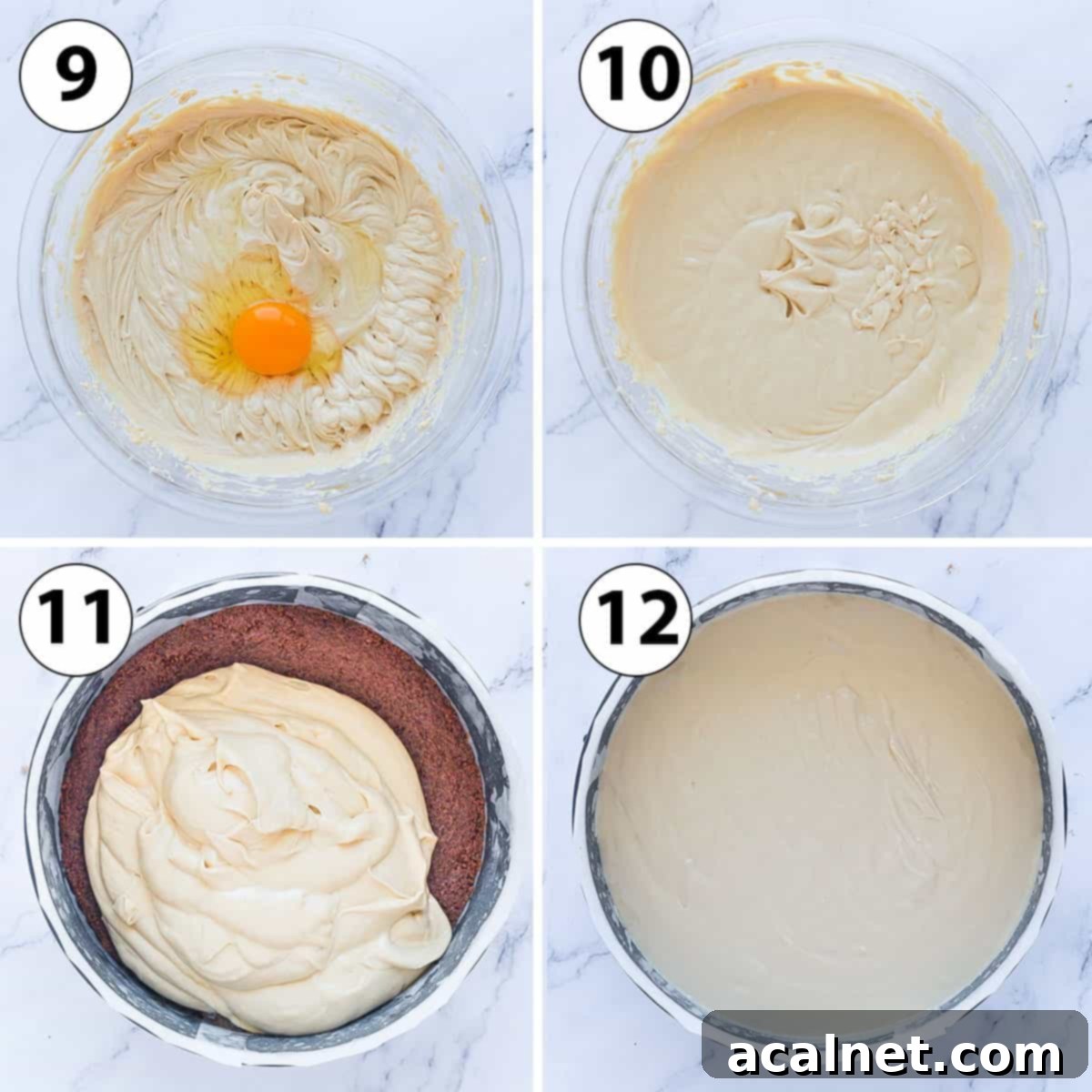
Pro Tips for a Perfect Baked Cheesecake Without a Water Bath
Achieving a perfectly smooth, creamy, and crack-free baked cheesecake without the fuss of a water bath is entirely possible with these essential tips. Follow them closely for a flawless Biscoff cheesecake every time.
- All Ingredients at Room Temperature: This is perhaps the most crucial tip. Ensure your cream cheese, Biscoff spread, Greek yogurt, and eggs are all at room temperature. Cold ingredients will struggle to emulsify properly, leading to a lumpy batter and potentially a grainy texture in your finished cheesecake. Room temperature ingredients blend smoothly and evenly, creating a truly luxurious consistency.
- Do Not Over-Whisk the Cheesecake Batter: Unlike some recipes that benefit from aeration, a baked cheesecake needs minimal air incorporated into its batter. Over-whisking introduces too much air, which can cause the cheesecake to puff up excessively in the oven and then dramatically fall and crack as it cools. Mix on medium speed only until just combined and smooth.
- Tap Your Cheesecake to Pop Air Bubbles: After pouring the batter into the crust, gently tap the springform pan firmly against your kitchen counter several times. This action helps bring any large, trapped air bubbles to the surface, where they can be popped with a small skewer or toothpick. This simple step is highly effective in preventing cracks and ensures a beautifully smooth top surface.
- Bake It Low and Slow: High heat is the enemy of a smooth cheesecake. Baking at a low temperature (like 150°C / 300°F) on the lowest rack of your oven allows the cheesecake to set gently and evenly from the edges to the center, minimizing the stress on the structure that often leads to cracks. This method ensures a perfectly creamy texture throughout.
- Allow Gradual Cooling in the Oven: A sudden change in temperature is the primary cause of cheesecake cracks and collapse. Once your cheesecake is baked and set, turn off the oven but leave the cheesecake inside with the door slightly ajar for about an hour. This gradual decrease in temperature allows the cheesecake to adjust slowly, preventing thermal shock. After this period, remove it from the oven and let it cool completely to room temperature before transferring it to the fridge. This slow cooling process guarantees a beautiful, crack-free Baked Speculoos Biscoff Cheesecake.
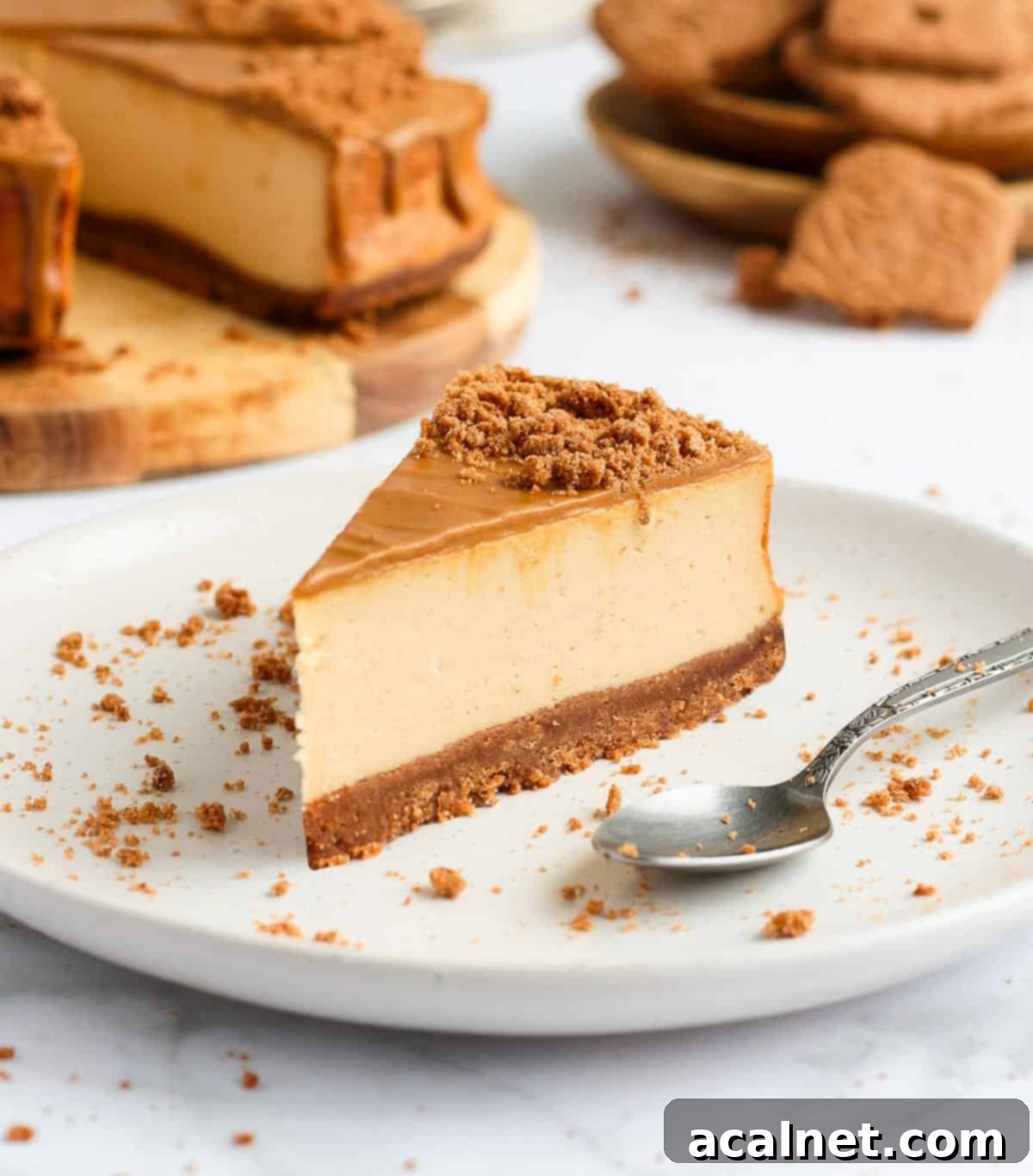
Baked Biscoff Cheesecake: Your Questions Answered
Basically, yes, they are essentially the same type of cookie. Biscoff is the well-known branded name given to traditional Speculoos Cookies by the Belgian company Lotus when they began marketing their popular spiced biscuits outside of Europe. The proper, traditional name is Speculoos or Speculaas, particularly used in Belgium and the Netherlands, while Biscoff is the internationally recognized brand name for these distinctively caramelised and spiced cookies.
Biscoff Cookies – or Speculoos/Speculaas Cookies – are characterized by a unique combination of a special kind of caramelised dark brown sugar, often made from beets (known as “vergeoise brune” in Belgium), and a distinct blend of warming spices. The exact spice mix can vary slightly based on the region or brand, but it typically includes aromatic spices such as Cinnamon, Nutmeg, Cloves, Ginger, and/or Cardamom. The flavor profile of Biscoff is often compared to gingerbread, but it’s distinguished by a deeper, more complex caramelised sweetness and a more intensely spiced, aromatic quality.
Yes, these terms generally refer to the same delicious product. It often comes down to regional naming conventions and branding. Speculoos Spread or Speculaas Spread is the traditional name used in most parts of Europe, directly referring to the crushed Speculoos cookies from which it’s made. Biscoff Spread is the specific, branded name for the spread produced by Lotus, derived from their Biscoff cookies. Cookie Butter is a more generic or internationalized name, widely adopted by other brands, particularly in North America, to describe this type of spiced, crushed cookie spread. Regardless of the name, they all offer a similar, irresistible flavor profile for our Biscoff Cheesecake.
For this particular recipe, I have thoroughly tested both methods: baking it in a water bath and baking it directly in the oven. My findings consistently show that the texture of this Baked Speculoos Cheesecake is significantly superior and much, much nicer when baked without a water bath. The method outlined in this recipe, focusing on low heat and gradual cooling, ensures a perfectly creamy and crack-free result. Therefore, I personally do not recommend baking this Biscoff cheesecake in a water bath.
Storing Your Baked Speculoos Biscoff Cheesecake
To keep your delicious Speculoos Biscoff Cheesecake fresh and flavorful, it’s best stored in the refrigerator. This baked cheesecake will remain fresh and delightful for up to 3 days when properly stored. To prevent it from absorbing any unwanted odors from other foods in your fridge, make sure to cover it tightly with plastic wrap or aluminum foil. While tempting, I do not recommend freezing this particular Biscoff cheesecake. Freezing can alter the delicate creamy texture, making it less enjoyable upon thawing.
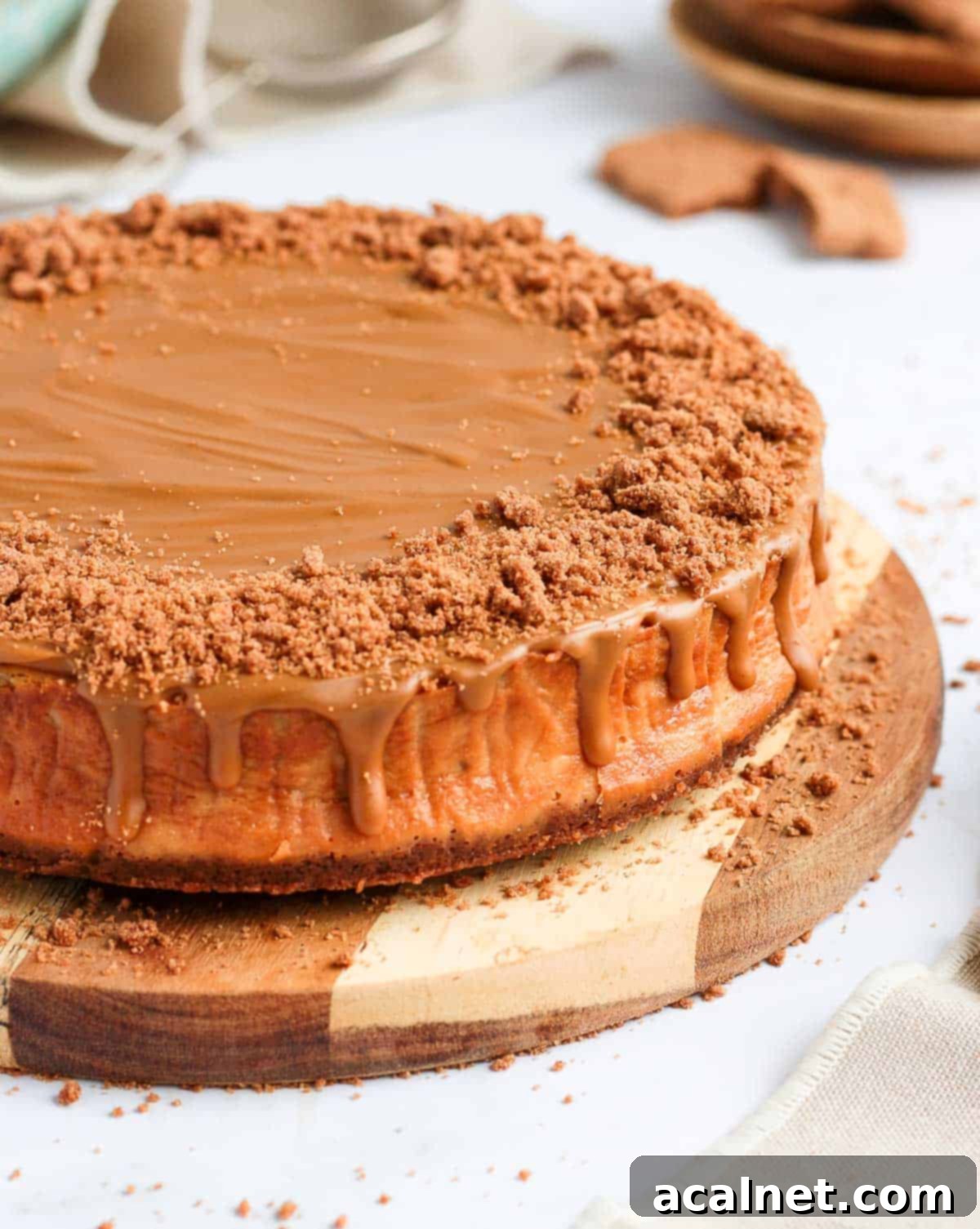
Explore More Delicious Cheesecake Recipes
If you’ve loved this Baked Biscoff Cheesecake, be sure to check out our other popular cheesecake creations for more delightful baking adventures:
- Lemon Ricotta Cheesecake
- Mini Blueberry Cheesecakes
- Apple Crumble Cheesecake
- Mini Lemon Cheesecakes
- Passion Fruit Cheesecake
- Coffee Cheesecake
- Mini Strawberry Cheesecakes
- Chocolate Orange Cheesecake
Recipe Card: Baked Speculoos Biscoff Cheesecake
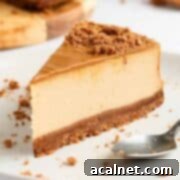
Speculoos Cheesecake (Baked Biscoff Cheesecake)
Print Recipe
Ingredients
Speculoos / Biscoff Crust
- 250 gr Speculoos / Biscoff Cookies, about 25 cookies
- 100 gr Unsalted Butter, melted
Speculoos / Biscoff Cheesecake Batter
- 500 gr Cream Cheese, at room temperature
- 200 gr Greek Yogurt, at room temperature
- 150 gr Speculoos / Biscoff Spread, or Cookie Butter Spread
- 50 gr Brown Sugar, or fine white sugar
- 2 large Eggs, at room temperature
Toppings
- 150 gr Speculoos / Biscoff Spread, or Cookie Butter Spread
- 4 Speculoos / Biscoff Cookies, lightly crushed
Instructions
Speculoos / Biscoff Crust
- Grease and Line a 24 cm / 9 inch Springform Pan with Baking Paper on both the bottom and sides of the pan.
- Finely crush the Speculoos/Biscoff Cookies in your food processor (see note 1 to make by hands) until you get thin crumbs. Add the melted Butter and pulse to combine. It should ressemble thick wet sand.
- Transfer the crumbs inside the Springform pan and very firmly pack them using the back of a spoon or a cup. Place in the fridge to chill for 30 minutes.
Speculoos / Biscoff Cheesecake Batter
- Preheat your oven on 150’C/300’F.
- Place the Cream Cheese, Greek Yogurt and Biscoff Spread in a large mixing bowl. Whisk together until combined and no lumps remain using an electric or stand mixer (see note 2).
- Add the Brown Sugar and whisk until combined.
- Mix in the Eggs, one at the time, until smooth and lump-free. Do not over-mix.
- Pour the cheesecake batter over the chilled crust and use the back of a spoon or an offset spatula to spread it out evenly.
- Bake on the lowest rack of your oven for 45 to 55 minutes, or until set (see note 3). Turn off the oven and leave the cheesecake to cool down inside the oven for about an hour. Remove from the oven and leave to finish cooling down at room temperature, then transfer in the fridge (see note 4).
Toppings
- Once the cheesecake is completely cool (at least 1 hour in the fridge), melt the Speculoos / Biscoff Spread in the microwave for a few seconds to get it very liquid/fluid. Pour it over the cheesecake and use a small offset spatula to push the spread towards the edges of the cheesecake and drip over.
- Coarsly crush the Speculoos / Biscoff Cookies and sprinkle around the edges of the cake.
- Keep in the fridge for up to 3 days.
Would you like to save this recipe?
We’ll email this post to you, so you can come back to it later!
Notes
- Different brands of Speculoos / Biscoff Cookies will have a different size cookie – so I recommend weighting them for more accuracy.
- All ingredients for the cheesecake batter need to be at room temperature to easily mix.
- The Greek Yogurt can be replaced by Natural Yogurt or Sour Cream if required, although I highly recommend using Yogurt for a lighter cake texture.
Instructions Notes
- The crust can be made by hands as well. Place the cookies in a ziplock or freezing bag and use a rolling pin to crush them finely. Transfer into a mixing bowl and stir in the melted butter with a spatula.
- If needed, melt the Spread in the microwave for a few seconds so it is fluid. Do not over-whisk the ingredients, we do not want to add to much air into the batter. Stop mixing as soon as no lumps remain and the batter is fluffy and fluid.
- To know the cheesecake is set, gently move the pan back and forth in the oven and see if the centre jiggles. If not, the cheesecake is ready. Try avoid opening the oven door too many times as it could make the cheesecake collapse. If the cheesecake seem to be browning or burning quickly, lower the oven temperature slightly.
- All these steps are to avoid any cracks or collapse of the cheesecake once it is baked. In most cases, cheesecake collapse or crack because of a sudden temperature change, so you want to let it cool down very slowly.
Nutrition (per serving)
Made this recipe?
Let us know if you liked it by leaving a comment below, and tag us on Instagram @a.baking.journey with a photo of your creation!
